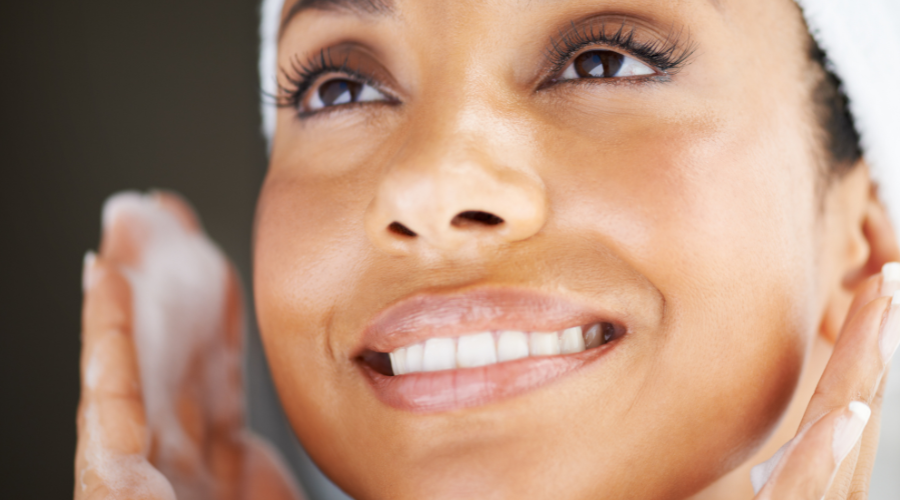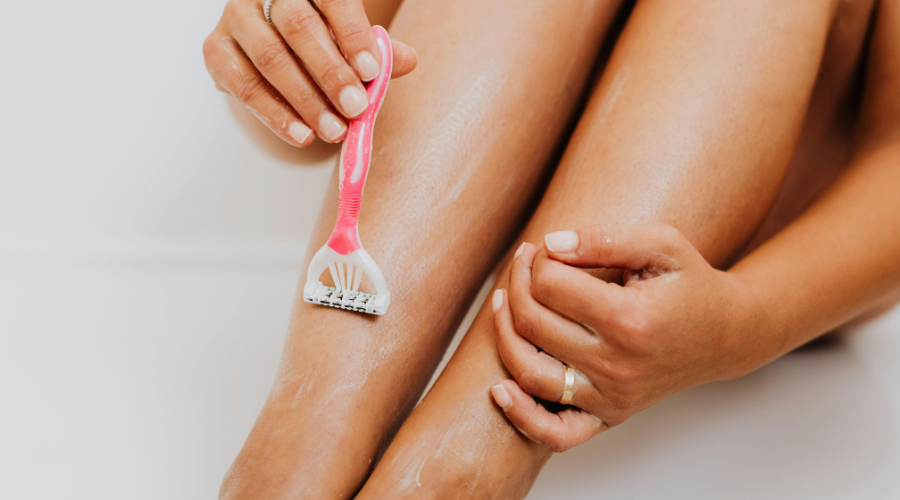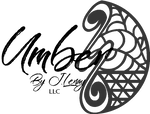My Top 5 Skincare Tips: How to Prevent and Treat Ingrown Facial Hairs

You wake up, look in the mirror, and notice those pesky ingrown hairs on your face staring back at you. We all get them from time to time, but if it seems like you have a perpetual crop of red, irritated bumps from ingrown hairs taking over your complexion, it may be time to learn how to prevent and treat them.
Ingrown hairs can happen anywhere you remove hair, but they seem especially annoying on delicate facial skin. The good news is that with some simple tips and techniques, you can get ingrown hairs under control and restore your skin’s natural glow. This article will walk you through the causes of ingrown facial hairs and provide actionable solutions. Get ready to say goodbye to those irritating bumps!
What Causes Ingrown Facial Hairs?
Ingrown facial hairs occur when hair curls back into the skin instead of growing out. Dead skin cells can trap hair follicles beneath the surface as they accumulate. The hair continues to grow under the skin, causing inflammation and irritation.
Improper shaving technique
Shaving too closely or in the wrong direction can lead to ingrown hairs. Always shave in the direction of hair growth using a clean, sharp razor. Rinsing with warm water first will soften the hairs, allowing for a closer shave.
Curly hair
Those with naturally curly hair are more prone to ingrown hairs. The curved shape of the hair causes it to double back into the skin. Using a moisturizer daily, especially after shaving or waxing, will soften hair and skin, making it less likely for hair to become ingrown.
Clogged hair follicles
Anything that blocks hair follicles, like dirt, oil, or product buildup, increases the chances of ingrown hairs forming. Wash the area regularly with a mild cleanser to keep pores clear. Exfoliating 1-2 times a week will also help unclog hair follicles and remove dead skin.

How do You Prevent Ingrown Facial Hairs?
Ingrown hairs suck. The good news is there are some steps you can take to prevent those pesky ingrown hairs from ruining your day.
Exfoliate
To prevent this, exfoliate the area regularly to remove dead skin.
Exfoliation removes those pesky dead skin cells, ensuring they don't get a chance to trap any new hairs. We're particularly fond of using a natural sugar scrub for this task. Sugar, with its small granules, is an excellent exfoliant, gentle yet effective at sloughing away dead skin. It's a natural humectant that helps the skin retain moisture, keeping it plump and hydrated.
This not only aids in preventing ingrown hairs but also promotes a vibrant, healthy-looking complexion. With a consistent exfoliation routine using a natural sugar scrub, your skin can become smoother and less prone to the irritation and inflammation caused by ingrown hairs.
Moisturize Daily
Moisturizing daily helps soften the skin and opens up the hair follicle. This makes it easier for hairs to grow in the right direction. Apply a fragrance-free moisturizer right after showering while your skin is still damp. Our facial moisturizer is a facial oil, because it’s 100% natural and offers the daily hydration your skin needs to balance sebum production. Our facial moisturizer helps soothe swelling due to acne, ingrown hair, eczema, or scarring- leaving your skin soft and hydrated.
Shave Carefully
If you do decide to shave, take your time and be gentle. Use a clean razor and shave in the direction of your hair growth. Rinsing with warm water will further soften the hair and open up the follicle. Apply shaving gel, oil or cream and let it sit on your skin for a few minutes before shaving. Rinse thoroughly when done and pat dry with a towel.
Hair Reduction Fade Oil
If you want to skip the razor altogether, try a hair reduction fade oil to help with your ingrown facial hairs.
A good hair reduction fade oil is formulated with a blend of ingredients that aims to reduce hair growth and soothe the skin.
Hair reduction fade oils contain a natural component that can help to minimize the thickness and quantity of facial hair over time. Ingredients like essential oils have properties that reduce the density of hair, and they might slow down the rate at which hair grows back after removal. This can be particularly beneficial because thinner, sparser hairs are less likely to become ingrown as they don’t have the same strength to curl back into the skin.
Moreover, this oil can provide a soothing effect on the skin, which is essential when dealing with ingrown hairs. Thanks to ingredients with anti-inflammatory properties, It can help reduce inflammation and redness associated with ingrown hairs. By calming the skin, these oils can also reduce the temptation to pick or scratch at ingrown hairs, which can lead to further irritation or even infection.
Regular application of a hair reduction fade oil may gradually result in less noticeable hair, a more even skin texture, and a reduction in the occurrence of ingrown hairs. This is because as the hair growth becomes finer and less coarse, there's less chance of hairs curling back into the skin and causing those uncomfortable, inflamed bumps.

How to Remove Facial Hair Properly
Removing facial hair the right way is key to avoiding ingrown hairs. The most common methods for hair removal—waxing, tweezing, and shaving—can all lead to ingrown hairs if not done properly. Here are some tips to keep in mind:
Waxing
When waxing facial hair, exfoliate the area beforehand to remove dead skin cells. This will open up hair follicles and allow for a closer, more effective wax. Apply a warm washcloth to the area after waxing to open pores and soothe the skin. Moisturize daily and exfoliate regularly between waxing appointments to prevent ingrown hairs.
Tweezing
Tweeze facial hair in the direction of hair growth and pull hair from the root. This reduces the chance of the hair breaking off under the skin. Cleanse the area first to remove excess oil and open pores. Apply a warm compress after tweezing to minimize redness and irritation. Exfoliate and moisturize the area daily to prevent ingrown hairs from forming.
Shaving
Use a clean, sharp razor and shave in the direction of hair growth. Rinsing the razor frequently under warm water will prevent clogs. Apply shaving gel, oil or cream and massage into the hair to soften before shaving. Rinse the area with warm water after shaving and pat dry gently. Avoid harsh toners or astringents, which can dry out and irritate the skin. Moisturize daily, especially in the first few days after shaving when ingrown hairs are most likely to form.
Removing facial hair properly and providing the right aftercare can go a long way toward preventing uncomfortable and unsightly ingrown hairs. Take your time, be gentle, and give your skin what it needs to heal. Your face will thank you!
Treating Existing Ingrown Facial Hairs
Those pesky ingrown hairs that have already formed need special care. Don’t pick at them—that will only make the inflammation worse and could lead to scarring. Instead, try these tips to gently coax them out and soothe your skin.
Exfoliate the area
Use a warm washcloth to apply gentle pressure to the ingrown hair. The heat will help soften the skin and open the pore, making it easier for the hair to release. You can also use a natural sugar scrub to exfoliate the area and loosen the trapped hair. Apply until the ingrown hair surfaces.
Apply a warm compress
Soak a washcloth in warm water and hold it over the ingrown hair for 10-15 minutes, a few times a day. The heat will help reduce inflammation, open the pore and make it easier for the trapped hair to emerge. You may need to do this for a few days to be effective.
Extract the hair properly
Once the ingrown hair starts to surface, you need to extract it properly to avoid further issues. Sterilize a pair of tweezers by wiping them down with rubbing alcohol. Grasp the hair close to the root and pull gently in the direction of hair growth. Don't yank the hair out, as this could damage the follicle or surrounding skin. Apply a dab of over-the-counter topical antibiotic ointment after extracting the hair to help prevent infection.
With patience and consistency, you can get rid of your ingrown facial hairs and enjoy smooth, bump-free skin again. Be gentle, take your time, and don't pick—your skin will thank you!




